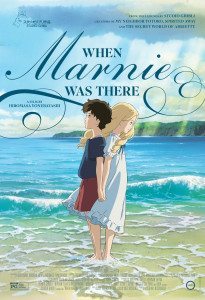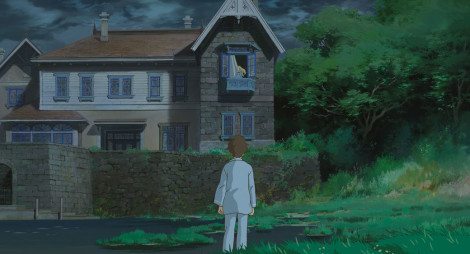When Marnie Was There
 Release Date: May 22, 2015 (USA)
Release Date: May 22, 2015 (USA)
Cast: Sara Takatsuki, Kasumi Arimura, Hana Sugisaki, Hitomi Kuroki
Director: Hiromasa Yonebayashi
Studio: Studio Ghibli
Distributor: Toho
Genre: Family, Drama, Mystery
Rating: ★★★★☆
Review Spoilers: Light
IMDB | Rotten Tomatoes | Wikipedia
Note: This review is based on the version of the film with Japanese audio and English subtitles. The English dub version has yet to be released.
When Marnie Was There is a deeply emotional movie for a few reasons. First there’s the obvious one: that the film touchingly depicts the friendship between its protagonists with an earnestness and commitment that demands personal investment and drives rollercoaster bouts of depression and elation. But beyond the content of the film, there’s also the looming overarching feeling that comes with watching the final work by one of the most unique and charming film companies in history.
To be fair, this isn’t officially Studio Ghibli’s final movie yet, but with creative head Hayao Miyazaki retired and the studio on indefinite hiatus, it looks to be a likely outcome. And given that, it’s surprising and perhaps regretful that Marnie lacks the imagination and surrealism that most people associate with the studio. Instead, the film follows in the footsteps of recent Ghibli productions From Up On Poppy Hill and The Wind Rises, delivering a mostly grounded story with only minor, relatively explainable fantasy elements.
Anna is an 12-year-old girl who suffers from asthma and, less explicitly, depression. To try to cure both, her foster parents send her to live with their relatives in a secluded seaside town for the summer. There she discovers and develops an infatuation with an abandoned mansion, and she begins seeing a blonde girl inside the old house in her dreams. Soon the girl appears in real life, introducing herself as Marnie, and showing her through the suddenly-livable mansion. The two agree to keep their friendship secret so that it remains special and intimate, but Anna fails to understand how any of this is possible, especially when a new family appears to move into the house.

But thankfully, the film gets away with it if only because that friendship remains so incredibly powerful and relatable. For a movie with child protagonists from a studio known primarily for their whimsy, Anna and Marnie have remarkably real-world stakes; Marnie struggles with her abusive nannies as her parents travel for months on end, while Anna suffers from an overwhelming guilt stemming from her knowledge that her foster parents receive government subsidies for housing her. They each come from a place of childlike desperation such that the sweet and pure-hearted innocence of their friendship doubles in potency.
Throughout Marnie, director Hiromasa Yonebayashi and his crew dare to take the characters to emotional extents that few would dare, even including Miyazaki himself. Within minutes of her first appearance on screen, Anna doubles over in tears in the midst of an intense asthma attack, thinking “I’m a horrible person.” Any hope of a lighthearted escapist fairytale disappears instantly in this bold opening that sets the tone for the story to come.
Additionally, it’s difficult to watch the film without picking up distinct lesbian undertones. Anna feels strange among her peers, like an outsider, and fails to relate to them; she wears boyish clothes and short hair, while Marnie sports dresses and flowing locks; she feels jealous when she sees Marnie dancing with an older man. It’s unmarked territory for an animated film with preteen protagonists, and it serves to make the eventual final twist all the more fascinating.

And one of the film’s largest selling points is Takatsugu Muramatsu’s fabulous soundtrack, which sets a romantic and moving road map for the story beats, capped off with a tender original ballad “Fine On The Outside” by American artist Priscilla Ahn. The song sums up the themes and emotions of Marnie near perfectly, and if you’ve managed to go the whole movie without crying, it’s sure to set you off.
Final Thoughts: While it may have some problems in terms of tone and focus, the best parts of When Marnie Was There make for a bold and legitimately touching film. It may be a strange note for the end of Studio Ghibli as a company, but it’s certainly a memorable one.
I cant look at the moon anymore without crying.